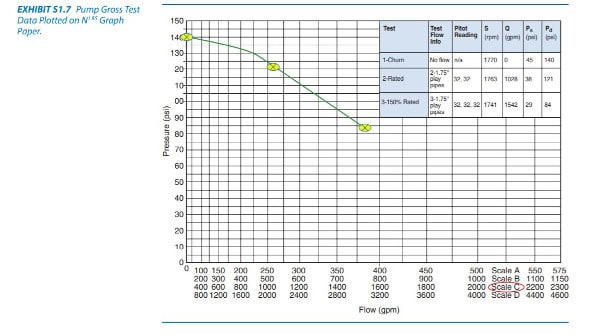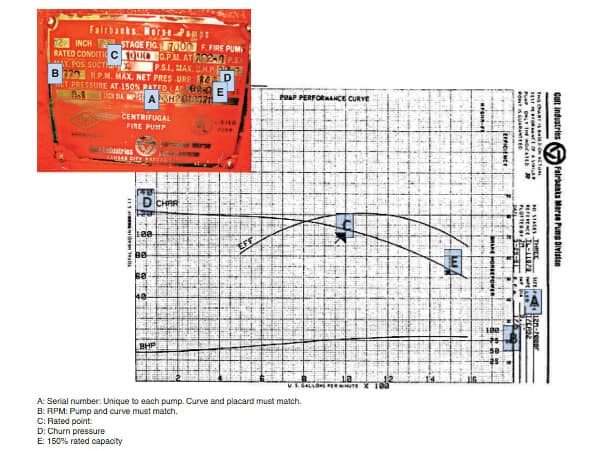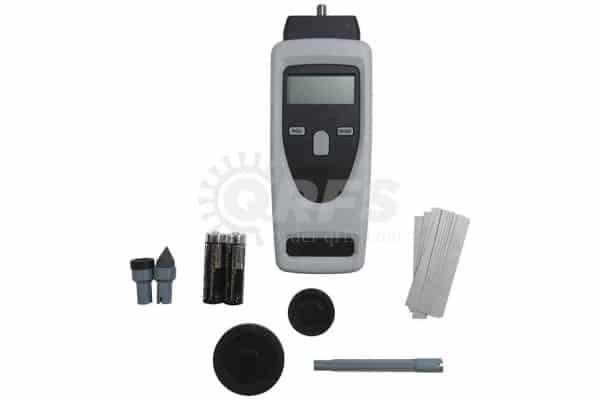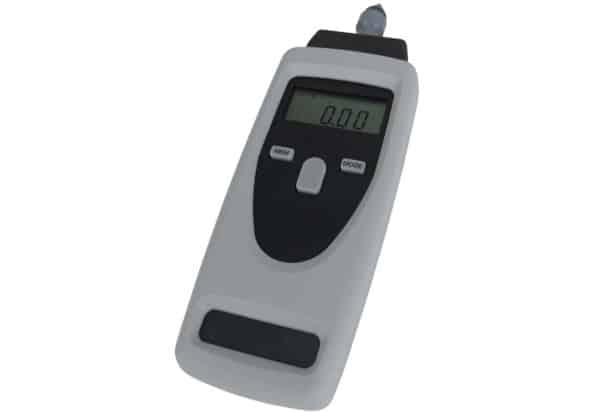Digital tachometers offer unmatched accuracy and ease of use in fire pump tests
Handheld tachometers serve as critical inspection, testing, and maintenance (ITM) tools for fire protection systems. They help ensure that malfunctioning fire pumps won’t cause fire sprinklers to fail during an emergency.
In this blog, we explain when digital tachometers are used during fire protection system ITM. And, given that life safety is on the line, we show why advanced handheld digital tachometers may offer the best solution. They provide the most accurate readings and have a versatility that simpler models or analog tachometers can’t match.
In the market for a digital tachometer? Be sure to check out our 809 Fire Pump Team Flow Test Kit.
What kind of handheld tachometer works best?
A tachometer is essentially a counting device. It measures how quickly a rotating object such as an engine shaft or disk completes a full spin. Tachometers then use this count to measure the object’s rotational speed, usually displayed as revolutions per minute (RPM).
Handheld tachometers are most often used to determine the speed and RPMs of small motors, engines, gears, or fans. They are versatile enough to gauge the RPM of lawnmower blades, industrial printers, generators, machine lathes, boat propellers, and more. The precise measurements provided by digital tachometers also make them useful for calibrating larger tachometers that are used on aircraft or motor vehicles.
Tachometers function in two ways:
Contact tachometers have a tip, generally referred to as an adapter, that rests against the spinning object. The adapter rotates with the object to calculate its RPM. Contact tachometers can be impractical in some situations, however, such as when equipment is hard to reach because it is behind a cage or other protective barrier.

Non-contact tachometers measure RPMs without touching the spinning surface. Instead, they use a laser, infrared light, or another light source to take measurements from a distance. A non-contact tachometer emits a beam of light that counts each time a reflective mark placed on the spinning object completes a full rotation. Marks might be made by paint markers, for instance, or strips of reflective tape.

The most advanced tachometers can do both, giving inspectors the ability to choose which method works best in every situation. And because getting the necessary measurements can take time, lightweight handheld tachometers offer the greatest ease of use.
Watch this video for a demonstration of how a digital handheld tachometer can transition between contact and non-contact applications:
A variety of handheld tachometers are available to serve different needs. Traditional analog tachometers provide immediate readouts using a dial. But the many extra conveniences offered by digital tachometers have pushed them to the forefront of the market in recent years.
Advanced digital tachometers:
- Make measurements easy to read on an LCD or LED screen.
- Save measurements to memory. This helps users keep their measurements organized and limits the need to measure a second time.
- Convert RPM readings into other measurements, such as feet per second.
- Offer extreme precision and accuracy. Some high-resolution digital tachometers can measure RPM to a hundredth of a rotation with a barely recognizable margin of error. For high-precision applications, some manufacturers will even provide in-house or laboratory calibration to the standards of the National Institute of Standards and Technology (NIST).
To learn more about digital tachometers or for more detailed help selecting the type of tachometer you need, read our previous blog, “Which Handheld Digital Tachometer is Right for Me?”
When are handheld tachometers required for fire protection system ITM?
Digital handheld tachometers play a leading role in what many consider one of the most critical ITM activities: testing fire pumps.
Fire pumps play a vital part in many fire protection systems, driving the necessary pressure to keep water flowing when the water supply doesn’t natively generate it. In such cases, sprinklers won’t operate correctly without a functioning pump—and the midst of a fire isn’t the time to figure out that your fire pump isn’t working right.
No-flow fire pump testing
The 2020 edition of NFPA 25: Standard for the Inspection, Testing, and Maintenance of Water-Based Fire Protection Systems (8.3) generally requires qualified personnel to perform no-flow, or churn, tests weekly for diesel motor-driven fire pumps and monthly for electric motor-driven fire pumps. Churn pressure is the minimum flow for a pump.
No-flow tests are exactly what they sound like: they don’t require flowing water. The purpose of completing a no-flow condition test is to verify the automatic or manual operation of the fire pump upon demand.
The test also ensures continuous delivery of the required system output, making sure the pump will run without overheating or developing unacceptable operating conditions. It can uncover issues that visual inspections can’t spot.
Generally, professionals inspect the pump’s pressure and evaluate how long it takes for the motor to achieve that pressure during the test, making any necessary adjustments.

As part of the test, NFPA 25 (8.3.2.9) requires qualified personnel to check the operating speed (RPM) of the motor, noting the time it takes to reach the pump’s rated speed. In its explanation of testing procedures for no-flow tests, the NFPA 25 Handbook notes that diesel and electric motors should reach the pump’s rated speed within 20 seconds. Operators are instructed to watch for, record, and quickly address abnormalities such as excessively low or high driver speeds.
For electric pumps, the NFPA 25 Handbook suggests measuring RPMs at the pump shaft with a handheld tachometer.
On listed diesel fire pump drivers, a built-in tachometer is required instrumentation. But the NFPA 25 Handbook notes in Chapter 8 that handheld units “are typically more accurate.” For diesel pumps, it suggests taking the operating speed measurement from the engine’s instrument panel and verifying it with a handheld tachometer.
Annual fire pump flow testing
NFPA 25 (8.3.3) requires an annual fire pump flow test to fully assess a fire pump’s capabilities. The test measures flow and pressure, ensuring the pump is ready to respond to a call to service under a variety of normal operating conditions.
Collected data is compared to the pump’s original performance curve to quantify any degradation in performance since it was installed. The test can also help uncover problems with the water supply, such as closed valves or obstructions between the supply and the equipment.
NFPA 25 (8.3.3.10) requires inspectors to measure a pump’s operating speed in RPMs during no-flow and flow conditions during the annual flow test. The NFPA 25 Handbook suggests using a handheld tachometer to record motor speed during churn, rated capacity, and 150% of rated capacity. It also suggests using handheld tachometers to verify readings from engine tachometers.
Handheld tachometers can be used with any flow-testing configuration, including hose streams or closed flow loops. NFPA 25 (A.8.3.7.1) says tachometers should be calibrated to the manufacturer’s specifications, noting that readings from equipment “with this level of accuracy and calibration” can be used without further adjustment.

RPM findings help determine the fire pump’s current performance curve, which is then compared to its original performance. The original pump performance data is typically available from the manufacturer’s pump curve. It can also be recorded on the fire pump design placard or nameplate, which should have been stamped with the original pump curve data.

Is any preparation required to use handheld tachometers for fire pump testing?
To measure operating speed during fire pump testing, handheld contact tachometers are simply placed on the end of a fire pump shaft. No preparation is required.
But if non-contact tachometers will be used, a small amount of preparation is necessary. Remember, non-contact tachometers—also known as photo, non-touch, or strobe-type tachometers—send out a beam of light that tracks how often a reflective mark on a spinning object makes a full rotation within a set amount of time.
Before testing begins, inspectors should verify where point readings will be taken and ensure that reflective marks are correctly applied. If a new mark must be made, its location should be carefully determined by considering factors that could impact results, such as proximity to casing spray, hot engine exhaust, and accessibility to the sides of a rotating shaft.
Manufacturers will often include reflective tape in tachometer kits or provide recommendations for reflective materials that will work. Generally, marks can be applied by a paint marker or strip of reflective tape—provided that the rest of the pump shaft has a dark or otherwise non-reflective surface.
Read this carefully: do NOT apply reflective tape or other markings to a shaft that already has a mark. False “double readings” can occur.

Checkline digital tachometers make precise fire pump measurements simple
Checkline’s combination contact and non-contact tachometers make it easy to accurately measure operating speed during fire pump tests. Made by Electromatic Equipment Company, a German manufacturer with six decades in the industrial measuring industry, these handheld digital tachometers offer the portability and precision inspectors need to be sure that fire pumps won’t fail when they’re needed most.
Checkline’s CDT 2000 HD model includes a cone tip and wheel contact adapters for measuring RPMs. Some users find that non-contact tachometers that emit visible light—rather than infrared—make it easier to accurately aim the tachometer at a distance.
When using the non-contact mode, the CDT 2000 HD sends a visible LED light beam that makes it simple to measure rotational speed by holding the device perpendicular to the spinning object. Users can take accurate measurements as far as 24 inches away.
In contact operating mode, the fire pump’s speed is sensed by direct contact between the end of the shaft and a contact adapter supplied with the tachometer.

At only 6 ounces, Checkline’s CDT 2000 HD is extremely lightweight—and measures only 8 3/8″ x 2 5/8″ x 1 1/4″ with the tip attached, and 6″ long without it. The device produces readings as fine as:
- 01 RPM for equipment spinning below 100 RPM
- 1 RPM for speeds between 100-1,000 RPM
- 1 RPM for speeds between 1,000 and 99,999 RPM.
Results can also be displayed in ft/min, in/min, m/sec, and ft/sec.
Measurements are accurate to 0.02%, and an on-target indicator confirms that measurements are reliable. A traceable calibration certificate is included.
A built-in memory stores maximum, minimum, average, and last readings for recall to the display. This helps increase ITM efficiency by limiting the need to waste time repeating tests.
Adapter durability is key to a contact tachometer’s longevity. Many inexpensive handheld tachometers feature low-quality rubber adapters that wear out quickly.
The CDT 2000 HD features a molded rubber shell for maximum durability. Its rugged construction, lightweight portability, and other outstanding features make it an ideal choice for maintenance personnel and ITM contractors performing fire pump tests.

Handheld digital tachometers help keep fire pumps and the systems that depend on them working in an emergency
Digital tachometers play a vital role in ITM of fire protection systems, ensuring that fire pumps will perform as expected during a fire. With exceptional accuracy, portability, and ease of use, Checkline’s CDT 2000 HD digital handheld tachometer makes it easier than ever for inspectors to perform these essential tests.
The Checkline CDT 2000 HD Combination Contact and Non-Contact Digital Tachometer comes as a kit with a slide-in contact adapter, 6” and 0.1-meter surface speed wheels, cone tip, funnel tip, extension shaft, reflective tape, two AA batteries (1.5 V), calibration certificate, and operating instruction manual, all packaged within a durable carrying case.
It is exclusively available as part of our 809 Fire Pump Team Flow Test Kit.
If you have questions or need help placing an order, call us at +1 (888) 361-6662 or email support@qrfs.com.
This blog was originally posted at blog.qrfs.com. Check us out at Facebook.com/QuickResponseFireSupply or on Twitter @QuickResponseFS.


